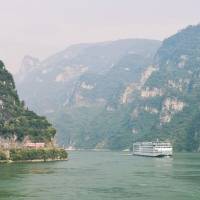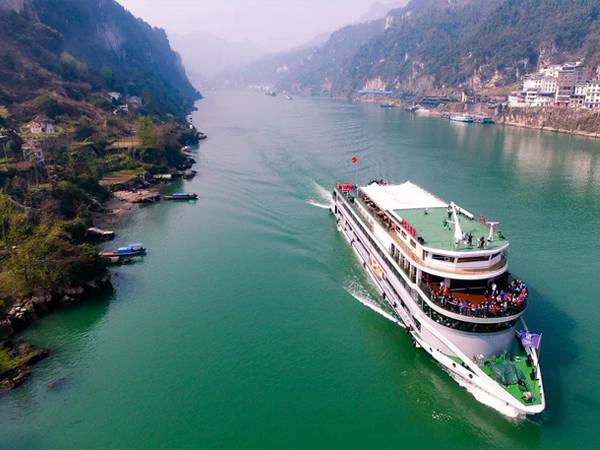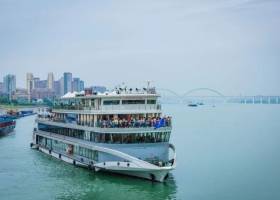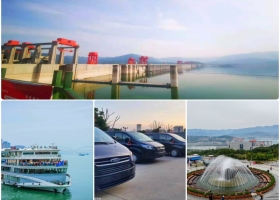武當道教文化內涵豐富,道教建筑、武當拳術、道家藥膳、服飾、音樂等給游者帶來無盡的享受。武當道教文化首推武當武術,在中華武術之中,享有“北崇少林,南尊武當”之美譽。
The tourists will have endless enjoyment with the profound Taoist culture and architecture, martial arts of Wudang, Taoist herbal cuisine, costumes and music. In terms of the Taoist Culture, the Wudang martial arts is regarded as the foremost, which enjoys the reputation that “in the north, Shaolin holds sway, while in the South, Wudang rules”.
聞名于世的武當內功和太極玄門劍,以靜制動,以柔克剛,煉氣凝神、剛柔并濟、內外雙修,是極佳的修身養性之術,武當山特產主要有:武當名茶、武當地
方特色酒、中草藥核桃、武當劍、拐杖等。
The world-renowned Wudang Neigong and Taiji Xuanmen Sword can overcome motion with standstill and hardness with softness, refine qi attentively, couple hardness and softness, and cultivate internally and externally, which are regarded as an excellent art of self-cultivation. The main specialty products in Mount Wudang are Wudang tea, Wudang local wine, herbs, walnuts, Wudang sword, crutches and more.
第二名:三峽大壩 Three Gorges Dam
三峽大壩,位于
西陵峽中段的湖北省
宜昌市境內的三斗坪,是當今世界上最大的水利樞紐工程。三峽大壩工程包括主體建筑物工程及導流工程兩部分,工程施工總工期自1993年到2009年共17年,分三期進行,到2009年工程全部完工。
Three Gorges Dam, located at the town of Sandouping, Yichang, Hubei Province in the middle section of Xiling Gorge, is the world's largest water conservancy project. It consists of two sub-projects, the main construction work and the river diversion work. The total construction period is 17 years from 1993 to 2009. Divided into three phases, the project has been completed in 2009.
大壩為混凝土重力壩,壩頂總長3035米,壩頂高程185 米,正常蓄水位175米,總庫容393億立方米,其中防洪庫容221. 5億立方米,能夠抵御百年一遇的特大洪水。配有26臺發電機的兩個電站年均發電量849億度。航運能力將從現有的1000萬噸提高到 5000萬噸,萬噸級船隊可直達
重慶,同時運輸成本也將降低35%。
The concrete gravity dam is 3,035 meters long on the top, and the dam top is 185 meters above sea level. The designed normal pool level of the reservoir is 175 meters, and the total storage capacity 39.3 billion cubic meters, of which 22.15 billion cubic meters is for flood control so that it can withstand 100-year catastrophic flood. The two power stations are installed with 26 generator units, with an annual output of 84.9 billion kilowatt-hours. The shipping capacity will increase from the current 10 million tons to 50 million tons, which will help the ten-thousand-ton fleet directly sail from Wuhan to Chongqing and reduce the transport costs by 35%.
三峽大壩建成后,形成長達600千米的巨型水庫,成為世界罕見的新景觀。隨著沿江山脈間人造湖泊的形成和通航條件的改善,原本分散在三峽周圍的許多景點更容易到達,如
小三峽、
神農溪千姿百態的仙境畫廊。
After the completion of the Three Gorges Dam, a huge reservoir stretching 600 kilometers long has been formed and become a new rare landscape in the world. With the formation of an artificial lake among mountains and the improvement of navigation condition, many attractions originally scattered around the Three Gorges will be more easily accessible, such as the Small Three Gorges, the wonderland gallery of Shennong Stream.
第三名:東湖 East Lake
東湖,位于武漢市武昌東郊,取其方位命名。東湖風景區是首批國家重點風景名勝區和國家5A級旅游景區,由郭鄭湖、水果湖、喻家湖、湯湖、牛巢湖 5個湖泊組成。
East Lake, located in the eastern suburb of Wuhan, is named for its location. The East Lake Scenic Area is one of the first national
總面積88平方千米,其中湖面33平方千米,是杭州
西湖的6倍。東湖煙波浩淼,碧水粼粼,水鳥翻飛,
游船如織,湖岸曲折,港叉交錯,素有九十九灣之稱。
With an area of 88 square kilometers including a water area of 33 square kilometers, the East Lake is 5 times larger than the West Lake in Hangzhou. With clear water, flying birds, numerous cruise boats, zigzagging lakeshores and crisscrossing ponds and brooks, it is known as the Lake of Ninety-nine Bays.
游覽區域分為聽濤、磨山、落雁、白馬、珞洪、吹笛六大景區。點綴其間的景觀有澤畔行吟、碧潭觀魚、水天一色、曲堤凌波、湖光浮閣、朱碑聳翠、雪海香濤、翠帷蘊誼、常春花苑等。景區內磨山南麓的中科院磨山植物園內有許多珍稀植物,極具觀賞價值。
The sightseeing areas are divided into six sections: Tingtao, Moshan, Luoyan, Baima, Luohong, Chuidi. Scattering among them are attractions such as Chanting along the Bank, Viewing Fish by Blue Pond and so on. Located at the foot of the south of Moshan Mountain, the Chinese Academy of Sciences’ botanical garden has many rare plants with high ornamental value.
第四名:黃鶴樓 Yellow Crane Tower
黃鶴樓,位于武漢市武昌蛇山峰嶺,北臨長江。與湖南
岳陽樓、江西
滕王閣并稱為“江南三大名樓”。享有“天下江山第一樓”的美譽。原址在湖北武昌蛇山黃鶴磯頭。
Yellow Crane Tower, crouching on the top of the Snake Hill in Wuhan and bordering the Yangtze River in the north, is one of the “three most famous towers on the south bank of the Yangtze River”, together with Yueyang Tower in Hunan and Tengwang Tower in Jiangxi, enjoying the reputation of “No.1 Tower in China”.
相傳它始建于三國吳黃武二年(223年),最初出于軍事上的需要,但后來逐漸成為文人薈萃,宴客、會友、吟詩、賞景的游覽勝地。其中,唐代《黃鶴樓》一詩,更是為詩人崔顥和黃鶴樓贏得不朽盛名。
It is said the Yellow Crane Tower was first built in the 2nd year of Huangwu of Wu during the Three Kingdoms Period (223 A.D.) for military purpose, and then gradually developed into the scenic spot where scholars hold banquet, make friends, recite poems, and enjoy sightseeing. And the poem Yellow Crane Tower written in the Tang Dynasty has won permanent fame for the author Cui Hao and the tower itself as well.
1700多年來黃鶴樓屢建屢毀,1957年建長江大橋武昌引橋時,占用了黃鶴樓舊址。現黃鶴樓在距舊址約 1000米左右的蛇山峰嶺上。樓共五層,高50.4米,攢尖頂,層層飛檐,四望如一。在主樓周圍還建有勝象寶塔碑廊、山門等建筑,整個建筑具有獨特的民族風格。登樓遠眺,“極目楚天舒”,萬里長江,三鎮風光,盡收眼底。
For the past 1700 years, the tower experienced repeated constructions and destructions. In 1957, the former site was occupied for the const








